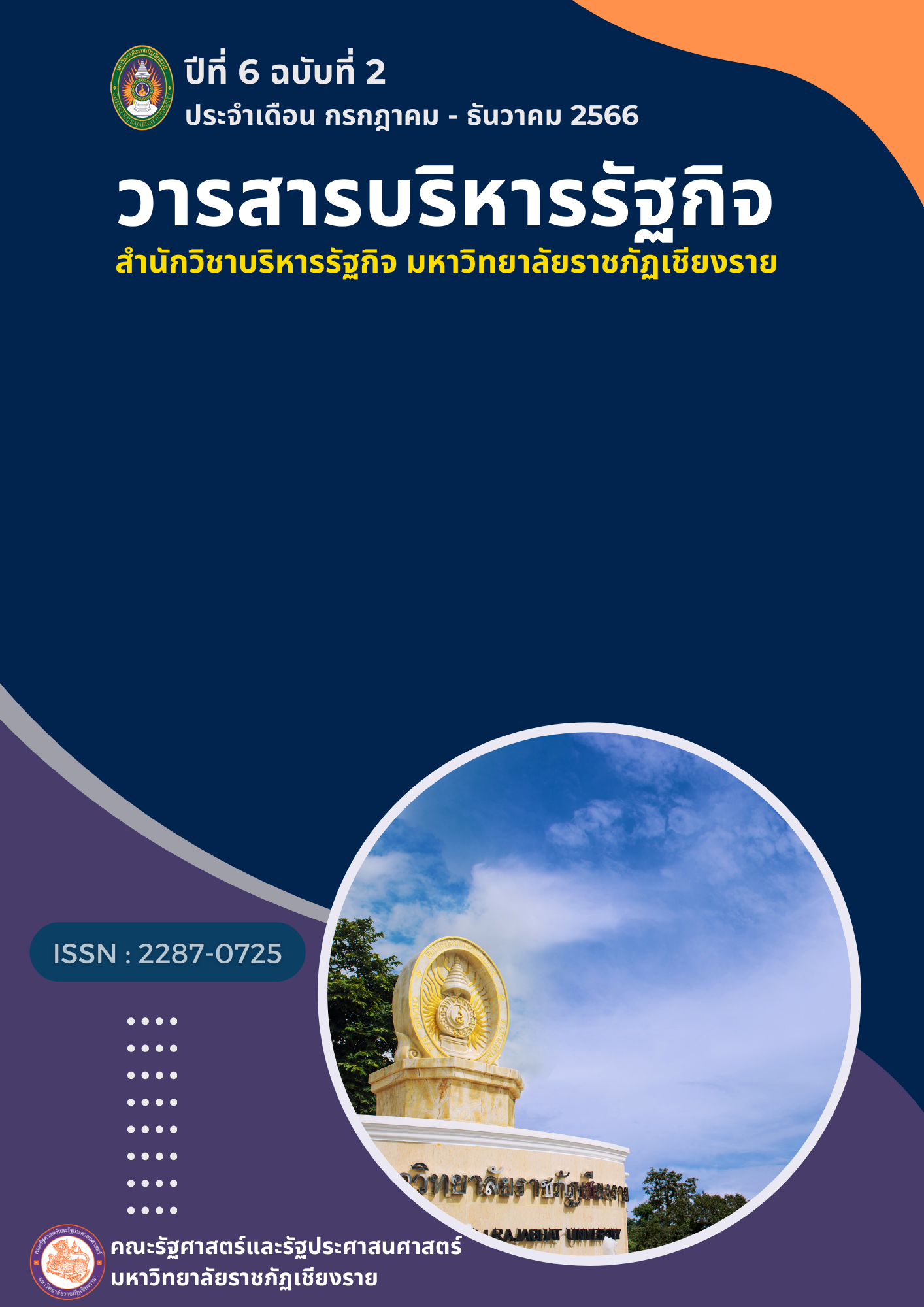The Development of Value-Added Potential in Products of Community Enterprises Entrepreneurs in Nonthaburi Province of Thailand
Main Article Content
Abstract
The objectives of this article are: To study the potential development of creating added value in products of community enterprises entrepreneurs in Nonthaburi province of Thailand. The potential development in this time is divided into 4 steps: 1) the importance of measuring the potential development of adding value in the product 2) measuring the development of the potential to create added value in the product 3) the component of the potential development creation of added value in products and 4) indicators that measure the components of the development of potential to create added value in products of community enterprises entrepreneurs, namely (1) product factors (2) process factors (3) ) staff performance factors, (4) personal learning factors, (5) factors for compensation of community enterprise members, (6) factors for information technology acceptance, and (7) strategic placement factors.
Article Details
References
เชาวนี แย้มผิว และจันทนา แสนสุข. (2564). กลยุทธ์เศรษฐกิจสร้างสรรค์ของผู้ประกอบการวิสาหกิจขนาดกลางและขนาดย่อมในจังหวัดพระนครศรีอยุธยา. วารสารวิชาการวิทยาลัยสันตพล, 7(1), 39-49.
ณัฐวุฒิ วิเศษ. (2555). ปัจจัยในการดำเนินธุรกิจของการเป็นผู้ประกอบการธุรกิจขนาดกลางและขนาดย่อม (SMEs) จังหวัดนนทบุรี. การวิจัยครั้งนี้ได้รับทุนอุดหนุนการวิจัยจากวิทยาลัยราชพฤกษ์ ปีการศึกษา 2555.
สำนักงานส่งเสริมวิสาหกิจขนาดกลางและขนาดย่อม. (2561). รายงานสถานการณ์ SME ปี 2561. สำนักงานคณะกรรมการพัฒนาการเศรษฐกิจและสังคมแห่งชาติ. แหล่งที่มา https://www.sme.go.th/upload/mod_download/download-20180912113024.pdf.
Alam, I. (2006). Removing the fuzziness from the fuzzy front-end of service innovations through customer interactions. Industrial marketing management, 35(4), 468-480.
Bruque, S., & Moyano, J. (2007, 27 May). OrganisationalDeterminants of Information TechnologyAdoption and Implementation in SMEs: The Case of Family and Cooperative Firms. Technovation.
Camisón, C., & Monfort-Mir, V. M. (2012). Measuring innovation in tourism from the Schumpeterian and the dynamic-capabilities perspectives. Tourism management, 33(4), 776-789.
Chan, D. (1998). Functional Relations among Constructs in the Same Content Domain at Different Levels of Analysis: A Typology of Composition Models. Journal of Applied Psychology, 83(2), 234-246.
Chen, J. S., & Tsou, H. T. (2007). Information technology adoption for service innovation practices and competitive advantage: The case of financial firms. Information research: an international electronic journal, 12(3), 3.
Damanpour, F. & Gopalakrishnan, S. (2001). The Dynamics of the Adoption of Product and Process Innovations in Organizations. Journal of Management Studies, 38(1), 65-84.
Djellal, F., & Gallouj, F. (2010). Services, innovation and performance: general presentation. Journal of Innovation Economics Management, (1), 5-15.
Droege, H., Hildebrand, D., & Heras Forcada, M. A. (2009). Innovation in services: present findings, and future pathways. Journal of Service Management, 20(2), 131-155.
Evangelista, R., & Savona, M. (2003). Innovation, employment and skills in services. Firm and sectoral evidence. Structural Change and Economic Dynamics, 14(4), 449-474.
Gallouj, F. & Savona, M. (2009). Innovation in service: a review of the debate and a research agenda. J Evo Econ, 19, 149-172.
Hall, C. M., & Williams, A. (2008). Tourism and innovation. Routledge.
Hipp, C., & Grupp, H. (2005). Innovation in the service sector: The demand for service-specific innovation measurement concepts and typologies. Research policy, 34(4), 517-535.
Hjalager, A. M. (2010). A review of innovation research in tourism. Tourism management, 31(1), 1-12.
Kirton, J. J., & Cooper, A. F. (2009). Innovation in Global health Governance. Innovation in Global Health Governance: Critical Cases.
Li, Y., Liu, Y., Duan, Y., & Li, M. (2008). Entrepreneurial orientation, strategic flexibilities and indigenous firm innovation in transitional China. International journal of technology management, 41(1-2), 223-246.
O’Cass, A., Song, M. & Yuan, L. (2012). Anatomy of service innovation: Introduction to the special issue. Journal of Business Research, 66(8), 1060-1062.
OECD. (2008). Tourism in OECD Countries: Trends and Policies. Paris: OECD Publishing.
Oke, A. (2007). Innovation types and innovation management practices in service companies. International Journal of Operations & Production Management, 27(6), 564-587.
Ordanini, A., & Parasuraman, A. (2011). Service innovation viewed through a service-dominant logic lens: a conceptual framework and empirical analysis. Journal of Service Research, 14(1), 3-23.
Pires, C. P., Sarkar, S., & Carvalho, L. (2008). Innovation in services–how different from manufacturing?. The Service Industries Journal, 28(10), 1339-1356.
Schumpeter, J. (1934). The Theory of Economic Development. (reproduced, New York: 1961). Cambridge: Harvard University Press.
Sundbo, J. (1997). Management of innovation in services. Service Industries Journal, 17(3), 432-455.
Uchupalanan, K. (2000). Competition and IT-based Innovation in Banking Services. International Journal of Innovation Management, 4(4), 455-489.
Vermeulen, P. A. M., O’shaughnessy, K. C., & De Jong, J. P. J. (2003). Innovation in SMEs: An empirical investigation of the input-throughput-output-performance model. EIM, Zoetermeer.
Weiermair, K. (2006). Prospects for innovation in tourism: Analyzing the innovation potential throughout the tourism value chain. Journal of Quality Assurance in Hospitality & Tourism, 6(3-4), 59-72.
Weng, M. H., Ha, J. L., Wang, Y. C., & Tsai, C. L. (2012). A study of the relationship among service innovation, customer value and customer satisfaction: An empirical study of the hotel industry in Taiwan. International Journal of Organizational Innovation, 4(3), 98-112.
Wu, C. H., Parker, S. K., & De Jong, J. P. (2014). Need for cognition as an antecedent of individual innovation behavior. Journal of Management, 40(6), 1511-1534.
Ye, B. H., Qiu, H. Z., & Yuen, P. P. (2011). Motivations and experiences of Mainland Chinese medical tourists in Hong Kong. Tourism Management, 32(5), 1125-1127.


